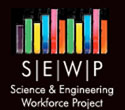WELCOME!
Welcome to the first edition of the Science and Engineering Workforce Project
(SEWP) News Digest! This publication is a product of the Science and Engineering
Workforce Project at the National Bureau of Economic Research, and is intended
to provide you with the latest news, research, reports and events relating to
the science and engineering workforce, on a bi-monthly basis. Four times a year,
we will publish in conjunction with Migration News, a product of the West Coast
Program on Science and Engineering Workers (
http://migration.ucdavis.edu/
), that focuses on the issues associated with international migration, in
regards to the science and engineering workforce.
>
Continue
FEATURED RESEARCH
America's
New Immigrant Entrepreneurs
By Vivek Wadhwa

|
In Americas New Immigrant Entrepreneurs, Vivek Wadhwa and his colleagues
at Duke University assess and analyze the contributions that immigrants have
made to the engineering and technology business sector. Of all of the science
and engineering companies started between 1995 and 2005, 25.3% listed an immigrant
as a key founder, with 32.5% of semiconductor companies and 31.7% of computer
companies founded by immigrants. Unsurprisingly, these companies are primarily
located in California, which hosts 34% of immigrant-founded companies, followed
by New Jersey with 7.3% of immigrant-founded companies. Twenty six percent of
immigrant-founded companies are founded by Indians, more than the combined shares
of immigrants from the UK, China, and Taiwan, the next highest origin countries.
The shares of international patents filed by Indians and Chinese have increased
as well, from under 2% each in 1998 to around 6% each in 2005. Immigrants to
the US have increased their inventiveness as well: patents filed by immigrants
increased from 7.3% in 1998 to 23.5% in 2005. The authors estimate that companies
founded by immigrants contributed $52 billion to the US economy between 1995
and 2005, creating 450,000 jobs.
> Full abstract & references
The Prognosis For Chemistry
In 2006, the National Research Council (NRC) Report,
Rising Above the Gathering
Storm: Energizing and Employing America for a Brighter Economic Future,
noted that only one of 120 chemical plants costing $1 billion or more being
built around the world is in the U.S., while 50 are in China. Earlier this year,
the NRC released a new report, titled
The Future of U.S. Chemistry Research:
Benchmarks and Challenges, which took a closer look at U.S. chemistry and
chemistry in other nations. The new report indicates that two important factors
behind the strength of U.S. chemistry today are English being the dominant language
of chemistry research and the dominance of the ACS's journals. It also points
out that the U.S. chemical research effort because of its sheer size cannot
be meaningfully compared with that of any other single nation. Comparisons need
to be with regional groups of nations in Asia and Europe.
> Full report
IMMIGRATION
Ethnic Scientific
Communities and International Technology Diffusion
By William Kerr
This study explores the importance of knowledge transfer for international technology diffusion by examining ethnic scientific and entrepreneurial communities in the US and their ties to their home countries. US ethnic research communities are quantified by applying an ethnic-name database to individual patent records. International patent citations confirm knowledge diffuses through ethnic networks, and manufacturing output in foreign countries increases with an elasticity of 0.1-0.3 to stronger scientific integration with the US frontier. To address reverse-causality concerns, reduced-form specifications exploit exogenous changes in US immigration quotas. Consistent with a model of sector reallocation, output growth in less developed economies is facilitated by employment gains, while more advanced economies experience sharper increases in labor productivity. The ethnic transfer mechanism is especially strong in high-tech industries and among Chinese economies. The findings suggest channels for transferring codified and tacit knowledge partly shape the effective technology frontiers of developing and emerging economies.
> Full paper
[PDF] INNOVATION
What Do We Really Know about When Technological Innovation Improves Performance (and When it Does Not)?
By J. Adetuniji Adegbesan and J.E. Ricart
Most approaches to innovation bear the implicit assumption that increased innovativeness leads to improved organizational performance. Thus, more attention has been focused on innovativeness than on innovation performance; on novelty than on value. However, recent empirical evidence calls into question the unqualified optimism surrounding innovation, and leads us to ask what we really know about when technological innovation improves performance. In this paper, we seek to make a contribution by presenting the results of an exhaustive review of extant knowledge on the outcomes of technological innovation.
Full abstract & links
Numbers*
2.7: U.S. Expenditure on R&D as
a percent of GDP (2004)
1.4: China Expenditure on R&D
as a percent of GDP (2004)
4,605: Researchers per million
people in the U.S. (2004)
708: Researchers per million people
in China (2004)
36.9: percent of middle-school
students in Shanghai that hope to become US citizens one day, according to a
survey published this year in the Labor Daily
275,000: Number of Chinese students
who have returned to China, out of the 1.06 million who have traveled overseas
to study since 1978.
35,000,000: Size of the Chinese
Diaspora (China is the world's largest source of emigrants).
*Numbers from
Unesco
Institute for Statistics and
Shanghai
Labor Daily





